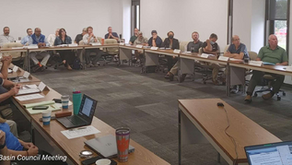Why Submerged Aquatic Vegetation is More than Climate Change
- JD Solomon

- Oct 26, 2023
- 2 min read

Communities of submerged aquatic vegetation (SAV) are important components of many freshwater, brackish, and marine aquatic ecosystems. Unfortunately, not only have the distribution and abundance of seagrasses in the northern Gulf of Mexico declined precipitously during the past 50 years, most notably from widespread deterioration of water quality, but submerged aquatic plant communities are also susceptible to long-term environmental changes that are predicted to accompany global climate change.
What is Submerged Aquatic Vegetation (SAV)
Submerged aquatic vegetation habitat is characterized by plants rooted into the ground and remaining under the surface of the water during all tidal stages. These plants form dense forests, called beds, which range in size from less than a meter to acres. North Carolina claims eight species, while Virginia and Maryland cite 20 species.
Known by Several Names
Seagrass, underwater grass, eel grass, and bay grass are other names for submerged aquatic vegetation. "SAV" refers to various rooted aquatic angiosperms or "underwater grasses" growing in shallow areas ranging from high salinity to freshwater tidal environments.
Many Benefits of SAV
SAV provides the following benefits:
prevents erosion by baffling the impacts of waves
removes nutrients and other pollutants from rivers and runoff
provides nursery habitat for fish, shrimp, and other species
provides forage for wintering waterfowl, sea turtles, and manatees
Valued Species Depend on SAV
Many species of fish that humans value depend on submerged aquatic vegetation for protection or as a predatory food source:
Bay Scallops
Shrimp
Hard Clams
Blue Crabs
Flounder
Red Drum
Sea Trout
Gag Grouper
Climate-Related Threats to SAV
The combined impacts of warming water temperatures, coastal zone acidification, water clarity, and overgrowth of competing algae threaten submerged aquatic vegetation in coastal estuaries. Other sources of threats to SAV include:
Uprooting by Boat propellers
Shading from the construction of piers and docks
Dredging and filling activities
Constructing hard shorelines that increase wave energy
Climate Change Reality or Hype?
The traditional line is that climate change may significantly impact SAV through temperature, atmospheric and weather changes, and sea level increases. There were documented impacts on eelgrass in the Chesapeake Bay as early as 2009. The Gulf of Mexico reported impacts as recent as 2017.
However, there is a lack of direct cause-and-effect linkage to climate change. Other sources, such as manmade dredging or hardened shorelines, are also primary factors. Natural responses of submerged aquatic vegetation to naturally occurring climate change cycles cannot yet be determined. Impacts to submerged aquatic vegetation have occurred, but not at rates predicted two decades ago.
Moving Forward
Submerged aquatic vegetation is a big deal. Manmade climate change advocates will continue to argue who is responsible and by how much. It really doesn't matter if you have new projects at the coast. One way or another, you will need to protect submerged aquatic vegetation.
JD Solomon Inc. provides solutions for program development, asset management, and facilitation solutions at the nexus of facilities, infrastructure, and the environment. Subscribe for monthly updates related to our firm.
JD Solomon is the author of Communicating Reliability, Risk & Resiliency to Decision Makers: How to Get Your Boss’s Boss to Understand and Facilitating with FINESSE: A Guide to Successful Business Solutions.










Comments